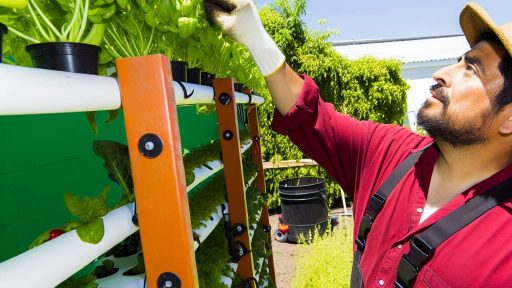Introduction to Sustainable Agroforestry
Definition of Agroforestry
Agroforestry integrates trees and shrubs into agricultural landscapes.
This practice combines agricultural and forestry technologies.
It enhances productivity while promoting environmental sustainability.
Small-scale farmers adopt agroforestry to optimize land use.
This method harnesses the benefits of both crops and trees.
Importance of Sustainable Agroforestry for Small-Scale Farmers
Sustainable agroforestry is crucial for enhancing food security.
It diversifies income sources for small-scale farmers.
Consequently, farmers reduce their dependence on single crops.
This approach mitigates risks associated with climate change.
Moreover, it improves soil health and fertility over time.
Environmental Benefits
Agroforestry contributes to biodiversity conservation.
It creates habitats for various species and communities.
This practice also helps in carbon sequestration.
Consequently, agroforestry combats climate change impacts.
It promotes the sustainable use of natural resources.
Transform Your Agribusiness
Unlock your farm's potential with expert advice tailored to your needs. Get actionable steps that drive real results.
Get StartedEconomic Advantages
Sustainable agroforestry improves farmers’ resilience to market fluctuations.
Additionally, it increases yields and overall farm productivity.
Farmers can access new markets by diversifying products.
This diversification also enhances food quality and nutrition.
Thus, it strengthens local economies by creating job opportunities.
Key Principles of Agroforestry: Integrating Trees and Crops for Environmental Benefits
Understanding Agroforestry
Agroforestry combines agriculture and forestry practices.
This method creates a sustainable system for farmers.
It promotes biodiversity while enhancing land productivity.
Farmers plant trees alongside crops or livestock.
These trees provide multiple benefits to the ecosystem.
Benefits of Tree Integration
Trees improve soil health by preventing erosion.
Additionally, they enhance nutrient cycling in the soil.
Moreover, tree roots help retain water in the landscape.
This capability supports crops during dry periods.
Furthermore, trees provide shade for sensitive crops.
Enhancing Biodiversity
Agroforestry promotes diverse plant and animal life.
This diversity strengthens the resilience of the ecosystem.
Birds and beneficial insects thrive in these environments.
Moreover, diverse crops reduce the risk of pest outbreaks.
Farmers, therefore, gain a more stable yield.
Carbon Sequestration
Trees act as carbon sinks, absorbing CO2 from the atmosphere.
This process mitigates climate change impacts.
As a result, small-scale farmers contribute to global efforts.
The integration of trees builds a sustainable future.
Showcase Your Farming Business
Publish your professional farming services profile on our blog for a one-time fee of $200 and reach a dedicated audience of farmers and agribusiness owners.
Publish Your ProfileBest Practices for Implementation
To maximize the benefits of agroforestry, farmers should plan efficiently.
Choose appropriate tree species that complement crops.
Furthermore, consider crop rotation and intercropping strategies.
Maintaining soil health is paramount for sustained productivity.
Lastly, continuous education on agroforestry techniques is crucial.
Benefits of Agroforestry for Small Farmers
Economic Advantages
Agroforestry improves farm profitability through diversified income sources.
By incorporating trees, farmers can harvest fruits, nuts, and timber.
This variety reduces reliance on any single crop.
Moreover, agroforestry can enhance market stability.
Diverse products appeal to more customers.
Additionally, tree planting can lead to lower input costs.
For example, trees provide shade and wind protection.
This can reduce water evaporation and soil erosion.
Consequently, farmers can save resources and expenses.
In essence, agroforestry creates a sustainable economic framework.
Ecological Benefits
Agroforestry significantly enhances biodiversity on farms.
This practice integrates trees with crops and livestock.
It creates habitats for various species.
Furthermore, it promotes healthier ecosystems.
Soil health improves due to organic matter from fallen leaves.
This leads to better nutrient retention and soil structure.
Additionally, agroforestry practices can increase water filtration.
Effective practices help manage water resources sustainably.
Moreover, tree roots stabilize soil and prevent erosion.
Agroforestry contributes to climate resilience in agricultural systems.
Social Impacts
Agroforestry fosters community ties among small-scale farmers.
Farmers often collaborate on agroforestry projects.
This can lead to shared knowledge and resources.
Moreover, the social benefits of agroforestry include enhanced food security.
Diverse crop production helps families meet nutritional needs.
Additionally, agroforestry practices can increase farmer resilience.
Farmers adapt better to market changes and climate variability.
Furthermore, educational programs around agroforestry raise awareness.
These initiatives empower communities to embrace sustainable practices.
Gain More Insights: The Role of Microgreens in Sustainable Urban Farming Practices
Different Agroforestry Models
Alley Cropping
Alley cropping involves planting rows of trees alongside crops.
This technique enhances soil quality and reduces erosion.
Crops benefit from shade, leading to improved yields.
Farmers can grow diverse plants in the alleys between trees.
Additionally, this model can enhance local biodiversity.
Showcase Your Farming Business
Publish your professional farming services profile on our blog for a one-time fee of $200 and reach a dedicated audience of farmers and agribusiness owners.
Publish Your ProfileIt also provides habitat for wildlife, promoting ecosystem health.
Silvopasture
Silvopasture integrates trees, pasture, and livestock in one system.
This model optimizes land use while providing multiple outputs.
Cattle benefit from shade, improving their health and productivity.
Meanwhile, trees provide timber and forages for livestock.
Moreover, it can improve soil quality by adding organic matter.
Farmers practicing silvopasture often report higher profits.
Forest Farming
Forest farming involves cultivating crops under an existing forest canopy.
This model is suitable for growing shade-tolerant plants.
Crops include medicinal herbs, mushrooms, and berries.
This approach maximizes land use without deforesting valuable trees.
Additionally, farmers can harvest non-timber products sustainably.
Forest farming contributes to the overall health of the forest ecosystem.
Discover More: Seasonal Gardening for Greenhouse Farmers
Best Practices for Implementing Agroforestry
Site Assessment and Planning
Proper site assessment is crucial for successful agroforestry implementation.
Begin by evaluating the land characteristics effectively.
Soil quality plays a significant role in agroforestry success.
Conduct soil tests to determine nutrient levels and pH.
Evaluate the landscape to identify sloping, flat, or hilly areas.
Consider the availability of water for irrigation and tree growth.
Assess sunlight exposure throughout the growing season.
Group the land into distinct zones based on its characteristics.
This zoning will aid in selecting appropriate plant species.
Choosing Suitable Plant Species
Select plant species that complement each other in agroforestry systems.
Consider native species, as they adapt better to local conditions.
Choose trees that provide shade, fruit, or timber based on needs.
Incorporate a mix of crops and tree species for biodiversity.
Consult local agricultural extensions for expert advice.
Evaluate how selected species will impact soil health.
Integrating Agroforestry with Existing Practices
Incorporate agroforestry practices into existing farming systems thoughtfully.
Align tree planting with existing crop rotations for efficiency.
Utilize hedgerows for windbreaks and biodiversity enhancement.
Consider alley cropping to maximize land use and yield.
Engage with local farmers who have experience with agroforestry.
Sharing insights can improve overall project success.
Monitoring and Adjusting Practices
Regular monitoring is essential for the success of agroforestry systems.
Track growth rates of trees and crops to identify issues early.
Adjust practices based on environmental changes and feedback.
Evaluate economic returns periodically to ensure profitability.
Be willing to change strategies to improve outcomes.
Showcase Your Farming Business
Publish your professional farming services profile on our blog for a one-time fee of $200 and reach a dedicated audience of farmers and agribusiness owners.
Publish Your ProfileEngage local agricultural support services for ongoing advice.
See Related Content: Indoor Gardening Tips for Small Spaces in Urban Farming
Soil Health Improvement Techniques
Enhancing Soil Fertility with Agroforestry
Sustainable agroforestry practices significantly improve soil health for small-scale farmers.
These practices promote nutrient cycling and reduce soil erosion.
Farmers can use diverse tree species to enhance soil intensity.
This enhances the microbial communities present in the soil.
Additionally, agroforestry increases organic matter in the soil.
Enhanced organic matter improves nutrient retention and water holding capacity.
Practices for Soil Enrichment
Cover cropping offers several key benefits.
- It prevents soil erosion by stabilizing the soil.
- Cover crops contribute organic matter to the soil.
- These crops enhance nitrogen fixation in the soil.
Contour farming also plays a vital role.
This technique minimizes runoff and captures rainwater effectively.
Diversity in Agroforestry Systems
Integrating various plant species promotes resilience against pests and diseases.
Diverse roots can reach different soil layers, improving nutrient access.
This diversity reduces dependency on chemical fertilizers.
Hence, farmers see an increase in overall soil fertility without additional costs.
Utilizing Organic Fertilizers
Organic fertilizers from composted materials enhance soil structure.
Using animal manure enriches the nutrient content in the soil.
Composting reduces waste while boosting soil health.
Farmers should adopt these organic practices for lasting soil health.
Uncover the Details: Sustainable Weed Management for Small-Scale Farming

Challenges and Solutions: Addressing Barriers to Adopting Agroforestry in Small-Scale Farming
Identifying Common Barriers
Small-scale farmers frequently face significant barriers when adopting agroforestry practices.
Limited financial resources often hinder their ability to invest in new systems.
Additionally, lack of access to information restricts their understanding of agroforestry benefits.
Moreover, traditional farming methods may discourage experimentation with new techniques.
Cultural norms can also play a role in resisting changes to established practices.
Providing Educational Resources
Education is vital for empowering small-scale farmers to adopt agroforestry.
Workshops and training sessions can deliver important knowledge on best practices.
Moreover, localized agricultural extension services can offer personalized guidance.
Additionally, farmers can benefit from sharing experiences and strategies with peers.
Financial Support and Incentives
Access to financial assistance can alleviate the burden on small-scale farmers.
Government programs offering grants or low-interest loans can support agroforestry adoption.
Furthermore, private organizations may provide funding for sustainable initiatives.
Incentives such as tax breaks may also encourage the shift to agroforestry systems.
Encouraging Community Involvement
Engaging the community is essential for successful agroforestry implementation.
Collaborative efforts can create support networks among farmers.
Community-led projects often increase interest and participation in agroforestry practices.
Additionally, local organizations can facilitate access to resources and training.
Demonstrating Success Stories
Highlighting successful agroforestry examples can inspire other farmers.
Case studies showcasing positive outcomes can build confidence in adopting new practices.
Furthermore, testimonials from local farmers can illustrate the tangible benefits.
Showcase Your Farming Business
Publish your professional farming services profile on our blog for a one-time fee of $200 and reach a dedicated audience of farmers and agribusiness owners.
Publish Your ProfileVisual aids and farm tours can also help convey effective methods and strategies.
Adapting Policies for Agroforestry
Government policies can significantly influence agroforestry practices among small farmers.
Encouraging policies can promote sustainable land use and agroforestry integration.
Additionally, revising land-use regulations can make agroforestry more accessible.
Supportive legislation can foster the development of agroforestry research and education.
Case Studies: Successful Implementation of Agroforestry Practices in Rural Communities
Introduction to Agroforestry Case Studies
Agroforestry integrates trees into farming systems, enhancing productivity.
This section explores successful case studies from rural communities.
These examples demonstrate practical applications and positive outcomes.
Case Study: The Moringa Project in Kenya
The Moringa Project transformed small-scale farms in Kenya.
Farmers planted Moringa trees alongside crops to improve soil health.
This integration increased biodiversity and crop yields significantly.
Additionally, Moringa leaves provide high-nutritional value for local diets.
Case Study: The Silvopastoral System in Colombia
Colombian farmers adopted a silvopastoral system for livestock management.
Trees were planted in pastures to offer shade and forage for animals.
This method enhanced animal welfare and improved pasture quality.
Consequently, farmers reported higher milk and meat production levels.
Case Study: The Coffee Agroforestry Initiative in Costa Rica
Costa Rican farmers implemented agroforestry techniques in coffee plantations.
Shade trees were introduced to protect coffee plants from harsh sunlight.
This practice preserved biodiversity and improved coffee flavor profiles.
Moreover, it increased resilience against climate variability.
Case Study: The Reforestation Effort in Ethiopia
Ethiopian rural communities engaged in extensive reforestation efforts.
Trees were planted to combat soil erosion and restore degraded land.
This initiative not only improved the local ecosystem but also livelihoods.
Farmers benefited from timber sales and improved crop production.
Common Benefits Observed Across Case Studies
These case studies reveal numerous benefits of agroforestry practices.
- Enhanced soil fertility through organic matter integration.
- Increased biodiversity, leading to natural pest control.
- Improved nutritional availability for local communities.
- Higher resilience to climate change impacts on agriculture.
Successful agroforestry practices provide holistic benefits.
They offer sustainable solutions for rural farmers and ecosystems.
Future Trends in Agroforestry
Innovations in Agroforestry
Agroforestry is evolving with innovative practices.
New methods integrate trees with crop and livestock systems.
This integration enhances biodiversity and productivity.
Small-scale farmers can leverage these trends for sustainability.
Technology in Agroforestry
Technology plays a crucial role in modern agroforestry.
Smart farming technologies are transforming traditional practices.
These include precision agriculture and remote sensing.
Farmers can monitor soil health and crop conditions effectively.
Data Analysis and Decision-Making
Data-driven approaches support better decision-making.
Farmers can use data to optimize their agroforestry systems.
This leads to more efficient resource use and increased yields.
Drones in Agroforestry
Drones offer a new perspective on agroforestry management.
They can assess crop conditions and identify pests effectively.
Showcase Your Farming Business
Publish your professional farming services profile on our blog for a one-time fee of $200 and reach a dedicated audience of farmers and agribusiness owners.
Publish Your ProfileMoreover, drones facilitate monitoring large areas quickly.
Community and Collaboration
Community engagement is vital for successful agroforestry initiatives.
Farmers benefit from shared knowledge and resources.
Collaborative projects can lead to innovative solutions.
Networked farmers can access new markets and technologies.
Sustainable Practices and Environmental Benefits
Future agroforestry trends emphasize sustainability.
Practices focus on improving soil health and reducing erosion.
Additionally, they help sequester carbon and enhance resilience.
These benefits support both the environment and farming communities.
Additional Resources
Farmers on the Frontlines of Climate Change: Challenges and …




